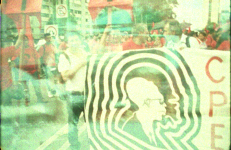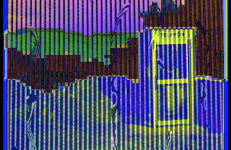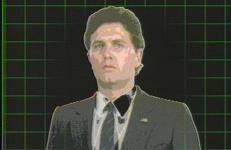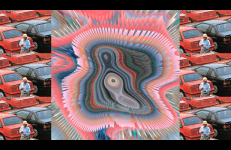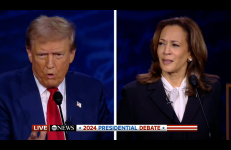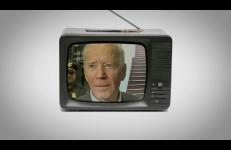A political composition on natural resistance. These images are an expiring breath in danger of extinction. These images become extinguished, consumed: a drop, a pure intensity which only appears when falling. In the presence of the image these audiovisual crowds become an affected body, assaulted by entropy. A face exhausted and reanimated by the continuous sound trance that traverses the battlefield. Faces for an eye that would not need to see.
Politics
Vice President Mike Pence eagerly plays cheerleader in chief for Donald Trump. In accepting the vice-presidential nomination in 2016, Pence proclaimed, “I'm a Christian, a conservative, and a Republican — in that order,” suggesting how we might understand his role. This ground-breaking, earth-shaking video begins with a pomp-ridden televised press conference, accompanied by uplifting music. Held early in 2017 at the White House Rose Garden, it showcased the president’s announced withdrawal from the historic Paris Climate Accord.
People enjoy my company connects the privatisation of telecommunications with techno-optimism, euphoria and online communication in the lead-up to the millennium.
The film explores the privatisation of the Irish state-owned telecommunications company Telecom Éireann from the viewpoint of shareholders communicating on early online forums. The event is contextualised within ideologies of technological emancipation in the pre-millennium period.
A satire of the political television spot, Perfect Leader shows that ideology is the product and power is the payoff. The process of political imagemaking and the marketing of a candidate is revealed, as an omnipotent computer manufactures the perfect candidate, offering up three political types: Mr. Nice Guy, an evangelist, and an Orwellian Big Brother. Behind the candidates, symbols of political promises quickly degenerate into icons of oppression and nuclear war.
A video essay set in the Mexican-U.S. border town of Ciudad Juarez, where U.S. multinational corporations assemble electronic and digital equipment just across from El Paso, Texas. This imaginative, experimental work investigates the growing feminization of the global economy and its impact on Mexican women living and working in the area.
"Persistence was shot in 1991-92 in Berlin, and edited with films by U.S. Signal Corps cameramen in 1945-46, obtained from Department of Defense archives. Interspersed through these materials are filmic quotations from Rossellini's Germany Year Zero (1946). A meditation on the time just after a great historical event, about what is common to moments such as these—the continuous and discontinuous threads of history—and our attachment to cinematic modes of observation that, by necessity, shape our view of events.
Bracketed by the Fall of Berlin Wall and the Collapse of the World Trade Center, a decade that saw the ossification of the neoliberal project, the rise of third-wave feminism, the proliferation of digital media, and even, perhaps, the “end of history": postmodernism; the emergence of internet; the commercialization of gangsta rap, and independent film; AIDS activist; digital cinema, the Gulf War; rave and riot grrrl cultures; reality television; MTV. A new diagrammatic system.
“A documentary about the Arkestra, but it's one whose presentation reflects the multilevel approach Sun Ra had to music and life in general. Jump cuts and split screens dot the visual stream with home movie footage from the Arkestra in Egypt during the 1970s to the Arkestra of today led by Marshall Allen. Director Ephraim Asili wisely divides the 40 minutes into distinct chapters, illustrating each with band interviews, live footage, visuals of planets and NASA launches, and his voice quoting writings from Ra.
A historical analysis of the on-going war in the Western Sahara. Liza Bear interviews Abdullah Majdid, the Polisario Front's United Nations representative. The tape addresses Morocco's U.S.-backed military effort to subjugate the indigenous Sahrawi population and annex one of the world's largest phosphate deposits, as well as the Sahrawis' conditions for a referendum.
Presidential candidates are sold like commercial products and naturally television is the ideal medium. Political Advertisement depicts the evolution of political ads over the last 44 years, beginning with Eisenhower in 1952 (which was an unqualified success), and continuing up to the most recent ad campaigns for Ross Perot, Bob Dole, and Bill Clinton in 1996.
Presidential candidates are sold like commercial products and naturally television is the ideal medium. Political Advertisement depicts the evolution of political ads over the last 44 years, beginning with Eisenhower in 1952 (which was an unqualified success), and continuing up to the most recent ad campaigns for Ross Perot, Bob Dole, and Bill Clinton in 1996.
Antonio Muntadas and Marshall Reese have been documenting the selling of the American presidency since 1984, and have expanded and updated the series with every election. Political Advertisement 2000 features ads from the 1950s up to the 2000 campaign. As Muntadas and Reese trace the development of the TV spot, what emerges is the political strategy and manipulative marketing techniques of the American televisual campaign process. Political Advertisement 2000 includes many rare spots, some never before seen.
Antonio Muntadas and Marshall Reese have been documenting the selling of the American presidency since 1984, and have expanded and updated the series with every election. Political Advertisement 2000 features ads from the 1950s up to the 2000 campaign. As Muntadas and Reese trace the development of the TV spot, what emerges is the political strategy and manipulative marketing techniques of the American televisual campaign process. Political Advertisement 2000 includes many rare spots, some never before seen.
The latest in Muntadas and Reese's series documenting the selling of the American presidency features political ads from the 1950s to ads from the 2004 campaigns, and highlights the development of the political strategy and marketing techniques of the TV campaign process.
Edited without commentary, the artists show an endless stream of candidates, from Eisenhower to Kerry, who are marketed like commercial products. As Muntadas and Reese trace the development of the campaign TV spot, what becomes apparent is a consistent sameness of political issues amid complex, changing visuals.
The latest in Muntadas and Reese's series documenting the selling of the American presidency features political ads from the 1950s to ads from the 2004 campaigns, and highlights the development of the political strategy and marketing techniques of the TV campaign process.
Edited without commentary, the artists show an endless stream of candidates, from Eisenhower to Kerry, who are marketed like commercial products. As Muntadas and Reese trace the development of the campaign TV spot, what becomes apparent is a consistent sameness of political issues amid complex, changing visuals.
The 2008 iteration Muntadas and Reese's series documenting the selling of the American presidency features political ads from the 1950s to ads from the 2008 campaigns, and highlights the development of the political strategy and marketing techniques of the TV campaign process.
The 2008 iteration Muntadas and Reese's series documenting the selling of the American presidency features political ads from the 1950s to ads from the 2008 campaigns, and highlights the development of the political strategy and marketing techniques of the TV campaign process.
The latest in Muntadas and Reese's series documenting the selling of the American presidency features political ads from the 1950s to ads from the 2012 campaigns, and highlights the development of the political strategy and marketing techniques of the TV campaign process.
The latest in Muntadas and Reese's series documenting the selling of the American presidency features political ads from the 1950s to ads from the 2012 campaigns, and highlights the development of the political strategy and marketing techniques of the TV campaign process.
The 2016 installment in Muntadas and Reese's series documenting the selling of the American presidency features political ads from the 1950s to ads from the 2016 campaigns, and highlights the development of the political strategy and marketing techniques of the TV campaign process.
The 2016 installment in Muntadas and Reese's series documenting the selling of the American presidency features political ads from the 1950s to ads from the 2016 campaigns, and highlights the development of the political strategy and marketing techniques of the TV campaign process.
The 2024 installment in Muntadas and Reese's series documenting the selling of the American presidency features political ads from the 1950s to ads from the 2024 campaigns, and highlights the development of the political strategy and marketing techniques of the TV campaign process.
The 2024 installment in Muntadas and Reese's series documenting the selling of the American presidency features political ads from the 1950s to ads from the 2024 campaigns, and highlights the development of the political strategy and marketing techniques of the TV campaign process.
The Political Advertisement project began in 1984, when New York-based media artists Muntadas and Reese produced their first compilation of American presidential commercials, beginning with Eisenhower in the 1950s. Every four years since — aligned to the national election cycle — they’ve updated the collection to reflect the current moment, presenting the clips in chronological order, with no voice-over editorializing, a tour-de-force of witty and incisive editing.
The Political Advertisement project began in 1984, when New York-based media artists Muntadas and Reese produced their first compilation of American presidential commercials, beginning with Eisenhower in the 1950s. Every four years since — aligned to the national election cycle — they’ve updated the collection to reflect the current moment, presenting the clips in chronological order, with no voice-over editorializing, a tour-de-force of witty and incisive editing.




